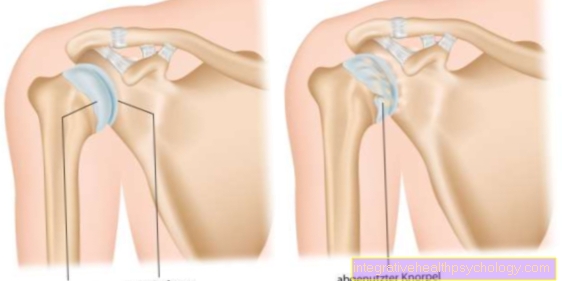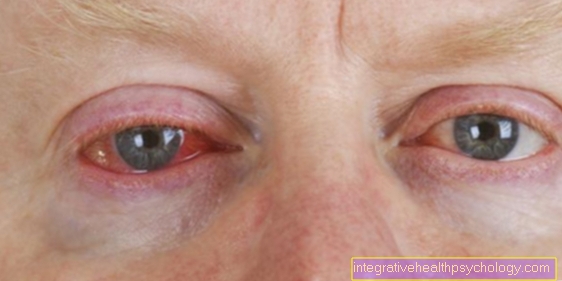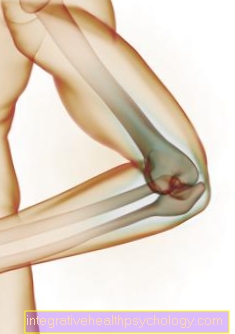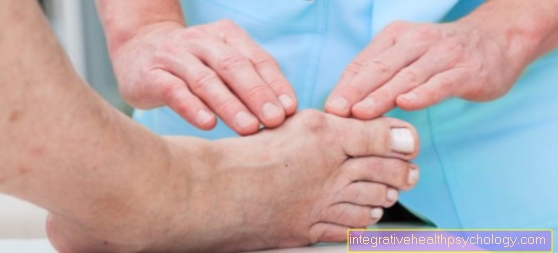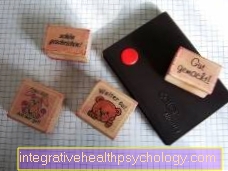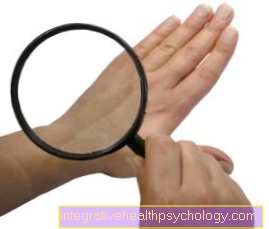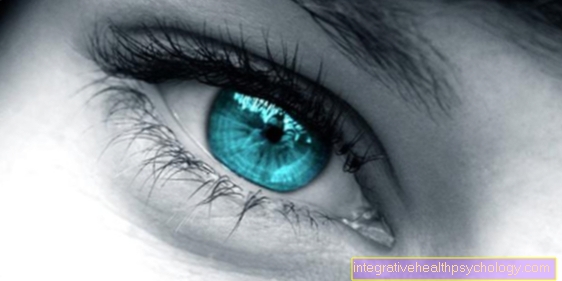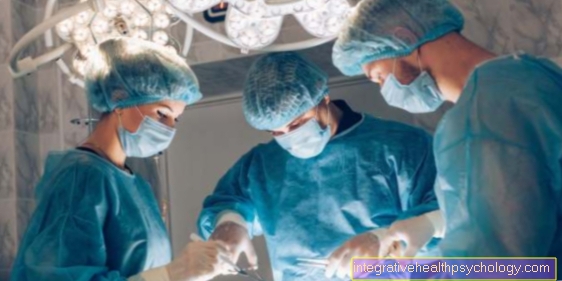Inflammation of a birthmark
General
The term birthmark is a synonym for the technical term Nevus. This means benign skin growths that contain different types of cells. These can be pigment-forming cells, sebum cells or blood vessel cells. The nevus does not have to be brown and can vary in shape and elevation. There are a large number of different nevi that differ in their cell composition.

In general, the term “birthmark” or “mole” means benign pigment cell nevi that are pigmented reddish to brown and can be of different shapes. There are certain criteria that can help to assess the quality (is it a benign mole or a mole with a tendency to malignant?). Using this so-called ABCDE rule (see below), you can check your own birthmarks in front of the mirror and consult a doctor at an early stage in the event of any noticeable changes. The dermatologist then takes a close look at all birthmarks from head to toe in a so-called screening examination and documents any changes. This is a very important form of cancer screening. The following article deals in detail with inflammatory changes and processes in birthmarks and how to recognize them.
Is the inflammation dangerous?
Inflammation can have different causes. They can occur in the context of bacterial infections, for example in the case of injuries to the skin, or they can also have their origin inside our skin. By scratching a birthmark, so that it sometimes even bleeds, germs of all kinds can enter. These can be skin germs, but also other bacteria that can accumulate in contaminated wounds, for example.
Inflammation can be recognized by the classic signs of inflammation. These five classic signs of inflammation further characterize the symptoms. Inflamed areas are reddened (Rubor), swollen (tumor), pain (Dolor), are warm (Calor) and sometimes restricted in their function (Functio laesa). Birthmarks can become inflamed in the same way as other skin areas.
Whether the inflammation of a birthmark is dangerous depends on where the birthmark is and which germs are responsible for the inflammation. If, for example, the germs are carried into the bloodstream, this can have serious consequences for those affected.
Read more on the topic: Pain in a birthmark
Is an inflamed birthmark a sign of cancer?
In general, one can differentiate between two large groups of skin cancer.
White skin cancer and black skin cancer.
The white skin cancer is the so-called basalioma. Basalioma is caused by frequent and high levels of sun exposure over a lifetime, for example when sunbathing without sunscreen for several years.
It is one of the benign skin changes, but in a few cases it can also spread. The basalioma often presents itself on the face in the form of an encrusted wound that does not heal for weeks.
Basalioma occurs more frequently in women who are fairly common. Therapy of basalioma consists in complete removal. The black skin cancer is melanoma. Melanoma is a malignant tumor with a high risk of spreading. The melanoma often goes unnoticed and is only noticed when metastases form, often in the brain or in the lungs.
Birthmarks have a higher risk of degeneration than other areas of the skin. An inflamed birthmark can indicate a degenerate process, but does not have to be. An inflamed birthmark is often caused by a simple infection. Due to the increased risk of degeneration, a doctor should always be consulted if a mole becomes infected. This can decide whether the inflammation is caused by bacteria or whether the birthmark has degenerated.
Depending on the findings, the inflammation can be treated. It is also advisable to examine all moles in the annual check-up by the dermatologist. This is part of cancer prevention and helps to identify and treat degenerations and neoplasms at an early stage. Particular attention must be paid to birthmarks that are present from birth. These have a longer time to grow and thus offer a higher risk of degeneration. If the pediatrician finds a birthmark in U1, U2 or U3, this should be observed by the dermatologist for life.
You might also be interested in: How can you recognize skin kebabs?
What does it mean when the birthmark is red?
A reddened birthmark can also indicate an inflammation. Here too, changes in the birthmark must be thought of as a degeneration.
How do I tell the difference between an inflamed mole and a pimple?
A birthmark is usually colored. There are different colors of a birthmark, usually these are brown.
A pimple, on the other hand, is usually the same color as the surrounding skin or is reddened. In addition, there is usually pus when pimples form. Most often, a pimple is a newly emerging structure that usually appears overnight and is tender to pressure.
A birthmark, on the other hand, grows slowly and is more likely to be noticed. The mole is usually different from a pimple in color and shape. When a birthmark is inflamed, there is also swelling and redness.
But here the original color of the birthmark is still preserved.If in doubt whether it is a mole or a pimple, a dermatologist should be consulted.
Birthmark is swollen, what's behind it?
There can also be inflammation behind a swollen birthmark. However, birthmarks are more at risk of degenerating than other areas of the skin. Therefore, every mole that changes should be checked. The annual check-up of all birthmarks on the entire body is part of cancer prevention.
Aching birthmark - what's behind it?
A birthmark can be painful if it is infected. In addition to pain, the inflammation often causes swelling and redness in the affected area.
A doctor should always be consulted if there is any change, reddening or pain in a birthmark. The inflammation should be treated with local antiseptics to prevent the germs from spreading into the bloodstream.
Otherwise blood poisoning can occur here (sepsis) come. There can also be a malicious process behind the painful birthmark. This is not often the case, but must always be taken into account in the differential diagnosis. If there are any doubts in this regard, a biopsy must be taken by the family doctor as a confirmation.
What to do if the birthmark festers?
The festering birthmark is usually an expression of an inflamed birthmark. The pus is made up of white blood cells that eliminate the germs in the wound. It is important that the birthmark should not be manipulated under any circumstances. That is, no attempt should be made to express the pus.
If you have a festering birthmark, you should also see a doctor. The doctor should remove the pus. It can then be treated with local antiseptics. The danger with a festering birthmark is the transfer of the pathogens into the bloodstream. This should be avoided by treating the infection early. Most inflammatory skin structures are caused by the Staphylococcus aureus pathogen. If this passes into the bloodstream, a sepsis (Blood poisoning).
What should you do if you have inflammation after a birthmark has been removed?
Inflammation after the removal of a birthmark occurs due to an infection of the resulting scar. If the wound is infected, the operating doctor should be consulted. Usually the wound can be treated with local antiseptics so that the germs in the wound are killed.
If the infection spreads into deeper skin layers, antibiotic therapy should be considered. Infection can be prevented by covering the wound well with a plaster after the mole has been removed and preventing water from getting on the wound. In addition, the patch should only be changed with clean hands.
ABCDE rules for assessing a birthmark
The ABCDE rules serve as described above Assessment of a birthmark (see: birthmark). Based on these criteria, you can determine whether the birthmark has changed and describe it in more detail. In this way, inflammation usually does not escape one. Inflamed moles stand out according to the criteria of these rules. They change in their shape and grandeur, often swelling, and their color can also change, for example they become reddish. In addition, inflamed birthmarks are painful and can even bleed or secrete purulent secretions. The formation of pus indicates bacterial colonization.
causes
1. Injuries
Inflammatory processes on birthmarks can indicate an observable or a malignant change. However, this does not necessarily have to be the case. The inflammation can be plain and simple small cracks in the skincaused by scratching, for example. Germs penetrate through the fine cracks and the tissue becomes inflamed.
2. Folliculitis (inflammation of the roots of the hair)
Also a hair can be the cause of an inflamed mole. Hair grows from some birthmarks, or to put it another way: Where a hair grows, there can also be a birthmark. An inflammation at the root of this hair is directly due to the birthmark and can be a cause. Hair root inflammation does arise preferably in very hairy areas, for example on the scalp or the male breast, can also occur in isolation, so that birthmarks with a hair can also be affected.
The germ that causes this inflammation is Staphylococcus aureus. It is a skin germ. Such Hair follicle inflammation is painful. Pressing on the inflamed area additionally increases the pain. As a rule, such mild inflammation heals without complications out. A antiseptic applied locally. Such an antiseptic is, for example Chlorhexidine. Antiseptics kill pathogens and can thus be used for topical therapy. If the inflammation of the birthmark or the hair follicle spreads to the surrounding tissue, you can carbuncle and boil arise. These are forms of Abscesses. You may need antibiotic therapy. As a rule, however, as already mentioned, such inflammations heal well without scars and without complications. Externally, the birthmark is swollen and it may appear yellowish.
3. Degenerate or potentially degenerate changes in a birthmark

Birthmarks usually consist of one Accumulation of pigment cellscalled melanocytes. As already mentioned above, other cell types, for example sebum cells, are also involved in their formation. Usually are Birthmarks benign growths of the skin. However, some of them can change. There may then be a risk of malicious (malignant) Growths from them develop from which ultimately Skin cancer arises.
There are signs that speak for a worrying change, but this does not mean that cancer is already present. Such changes are also manifested in features of inflammation. The best way to do that potentially malignant change Not to be overlooked, his moles should be checked regularly according to the ABDCE rules. Worrying changes can Color changes and a irregular coloring, for example redness. In addition, such birthmarks can be painful or even bleed. Growth or swelling should also be observed. Irregular or asymmetrical shapes are also more of a watchful thing. Sometimes scabs can also form on the surface of such birthmarks. Scab is coagulated exudate. The latter are inflammatory secretions from the tissue.
In summary, some of the more malignant changes in birthmarks are inflammatory in nature. Conversely, this does not mean that every malignant birthmark shows signs of inflammation. Nor does it mean that every inflammation is necessarily a sign of a malignant change. However, if you notice such changes in yourself, one should See a doctor and have the cause clarified. If it is a questionable development, the doctor will surgically remove the birthmark (see also: Removal of a birthmark). The goal is to prevent metastasis, i.e. spreading of the cancer, at an early stage, or to prevent the development of the cancer. Apart from the self-inspection at home, the statutory health insurance companies have been offering one since 2008 Skin cancer screening examination, the Skin cancer screening, on. All legally insured persons aged 35 and over are entitled to make use of this. The examination is carried out every 2 years by the family doctor or dermatologist. All birthmarks are inspected and assessed from head to toe.
4. Friction
The birthmark can be irritated by friction. Redness and swelling can occur here, but without an inflammatory reaction. These skin symptoms usually go away after a day. They are merely an expression of increased blood flow due to the resulting stimulus.
Summary
Inflammation of birthmarks can have different causes. For one, can PathogenSkin germs, for example, get into the inside of the mole through the smallest cracks and wounds, which can be caused by scratching, and cause inflammation there. In general, such an inflammation manifests itself as a swelling and Reddening of the birthmarkwhich can be painful. Another cause is one Hair root inflammation (Folliculitis). The birthmark can also appear whitish due to purulent accumulations. Folliculitis usually heals without complications. Antiseptics can be applied locally for therapy. Ultimately, inflammatory changes can also indicate a malignant (malignant) development. The ABCDE rules can help to specifically search one's moles for such changes, so that a doctor can be consulted at an early stage if a questionable development is suspected. If the suspicion is confirmed, the affected mole is usually removed.


